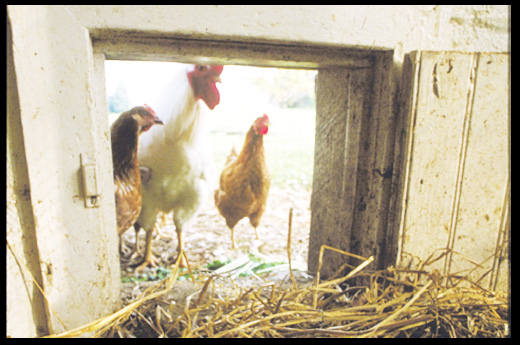by guest blogger Jean Nick, author and sustainability expert
After a few weeks, the thrill of having chicks in your dining room starts to wear thin, and the little fluffballs are transforming into feathery fliers who seem bent on flying out of any box ever created and then crying piteously to be put back in (after giving you a merry chase). While a wire mesh lid can extend their indoor stay a little, what they really need is a secure outdoor home.
When most people think of backyard chickens, they think of the birds either running around free or in a house with a permanent run. Both management systems have advantages and disadvantages, but there is a better way that optimizes the advantages and minimizes the disadvantages: a small secure but portable shelter with a bottomless run attached.
Why a movable coop?
A movable coop allows you to keep the chickens out of places you don’t want them wandering in (such as your best flower bed, where they can dig; the doorstep, where they can leave squishy presents; your neighbors’ yard, where they can pester your neighbors, hiding their eggs in interesting places—trust me, egg hunts get old fast—or the road, where they can play in traffic). It keeps them safe from predators (both wild and domestic), gives them access to fresh grazing (very important for their health and the nutrition of their eggs), and lets them spread their manure for you (so you don’t have to). When you are out in the yard to supervise, you can open the door and let them roam, if you like, but you don’t have to.
A movable coop arrangement also reduces the chances of diseases and pests (time and sunshine are great sanitizers) and can make your egg-laying friends less attractive to larger predators: Creatures on the hunt like to case the joint beforehand, and changing the layout every few days makes them uneasy.
When to move the coop
If you have even a small patch of lawn, you can find a new spot for a portable system every day or every few days and your grass will love you for it. Just days after the hens have been moved off a patch of grass, you won’t even be able to tell they were there; if you can, you need to relocate the pen more frequently.
Aim to move the pen around so that it takes at least 30 days to get back onto any area. Alternatively, you can “park” the portable pen on top of an existing or planned garden bed and let the chickens scratch, peck, and fertilize it into the best weed- and pest-free soil you’ve ever planted in (this is the best option during the period of the year when the soil is cooler than about 50 degrees F).
What coop to choose
At its most basic, a chicken pen is a rainproof shed or room that can be shut tight against the wind, with enough space for a nest (where the hens will lay their eggs) and a perch—not over the nest—where they will sleep (a 1-inch dowel or similar stick is perfect), and a larger area with mesh sides and an open bottom below or beside it. There are many good commercial setups if you have money to spend. An A-frame with the run underneath is easy to move and clean, and makes good use of yard space. Modular plastic shelters with runs, such as the Eglu, are also available. If you are handy you can quite easily build something similar, with help from purchased or free plans if you need guidance. For ease of portability, be sure your portable shelter is all one piece and includes wheels or runners, especially if you will be moving it by yourself. Depending on your climate, you may want to cover the top of the run with shade cloth or a waterproof tarp to provide shade and/or dry foraging area (you may have heard the expression “mad as a wet hen”; they much prefer not to get soaked, though they will put up with a drizzle).
One important pen construction note: Chicken wire is meant for keeping chickens in; it is NOT meant to keep chicken-eaters out (and everything likes chicken)!!! The average raccoon can rip through it in two seconds flat, and even our soft-mouthed Labrador retriever can get through it in a couple of minutes (I’ve watched her). Make your run out of 1-by-2-inch welded wire mesh, which is strong enough to keep out just about anything except a determined bear. It will cost more than chicken wire, but it will keep your chickens safe. (If you have bears, well, you may want to look into electric fencing to put around the area.)
How big a pen do you need?
You want at least 1 square foot of secure, protected area plus 4 to 8 square feet of outdoor playing area per standard-size hen. If you plan to let the chickens out to run for a while most days when you are outside to supervise, an area on the smaller end of the range will do.
How to set up the buffet line
You could use any old dishes for food and water, but hens will scratch all the food you give them out of an open dish onto the ground (where they will then ignore it and cluck insistently for more) and mess in their water; you’ll save money and lots of time in the long run if your furnish your portable chicken pen with a bulk feeder and a waterer. For easiest care, get units that you can hang from the top of the run or clip to its side, so when you move the pen, everything moves with it. The hens quickly learn about moving and line up clucking excitedly at the front end, ready to attack the fresh grass. Mount or hang dispensers so the food and water are chin height on the birds to help keep scratching feet and flung-up dust out. Hens need access to fresh water all day every day, and in the summer they will drink more and do better if that water is in the shade and cool. You may even want to refill waterers with cold water in midday hours during very hot weather.
What if you have no yard at all?
A large rabbit hutch, something like this one with an outdoor run, is an acceptable home for two or three hens. Look for or build one that has a draftproof area for sleeping and laying and as large and airy an outdoor area as possible. One with pullout trays on the bottom is easier to clean out and accumulates less mess underneath. Add a perch in the enclosed area and you are good to go.
 Jean Nick, has been writing about gardening and sustainable living for decades. She has worked at Rodale since 1991, and started reading Organic Gardening magazine in 1972. In her spare time, she gardens, helps manage a sustainable farm, listens to audio books, makes all manner of useful and tasty things, and comments on eco-logical and eco-nomical topics as Rodale.com‘s Nickel Pincher.
Jean Nick, has been writing about gardening and sustainable living for decades. She has worked at Rodale since 1991, and started reading Organic Gardening magazine in 1972. In her spare time, she gardens, helps manage a sustainable farm, listens to audio books, makes all manner of useful and tasty things, and comments on eco-logical and eco-nomical topics as Rodale.com‘s Nickel Pincher.





One great tip I just ran across in a British gardening magazine: spread a sheet of newspaper under the sleeping perch each evening to catch the night poops. Put the used one in the compost, complete with the girls’ “donations,” in the morning. This will keep the sleeping compartment much cleaner in the long run and save you trouble.
I was raised on a ranch. We built a mobile henhouse on wheels with chicken-wire arms that lowered and allowed the chickens out of the henhouse protected by a two-foot high wired enclosure. In the PM, the chickens would re-enter the henhouse, the “range” arms would be raised to lock the 2 entrance doors and the chickens would roost for the night.
The wheeled-mobile henhouse would be moved next AM to the next location – leaving chicken fertilizer to enhance the pasture grass. And the bug population in that area was severely reduced.
On the farm we use henhouses on skids inside 3 foot electromesh fencing enclosures, both of which get moved about once a week. We long since gave up shutting the hens in at night, their doors are always open. Moving the birds is the best way, no matter how many you have.
We had to protact the chickens at night because of coyotes. A pack tried to chew through the wood to the chickens one night – we covered that area with chicken-wire, too.
Nothing on four feet goes through energized electromesh fencing: http://www.premier1supplies.com/fencing.php?species_id=6 or http://www.kencove.com/fence/detail.php?code=NPC
I’m on the same page with what you are saying. Open discussion is what will help end it.
excellent issues altogether, you simply gained a emblem new reader.
What may you suggest about your put up that you simply
made some days in the past? Any positive?
It’s remarkable designed for me to have
a website, which is good in support of my experience.
thanks admin
We’ve found the best place to buy poultry supplies in the UK is http://www.durham-hens-poultry-supplies.co.uk/